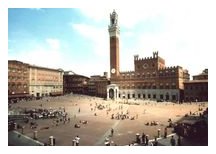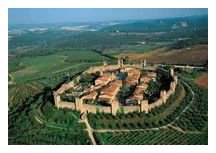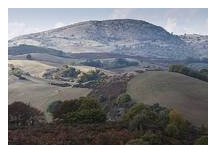 |  |  |
Siena
A city that needs no introduction, an unique atmosphere in the world. The severe palaces and steep alleys of the old town aging back to when Siena was an independent republic. Much of the old pride is still present in the temper of the citizens, which is expressed fully on July 2 and August 16 of each year during the famous Palio, perhaps the most ancient and authentic "festival of the people" in Italy. | San Quirico d'Orcia
Immersed in the beautiful Val d'Orcia, San Quirico d'Orcia is a fortress city which is much worth a visit. To be seen, certainly the Collegiate Church of Saints Quirico and Juliet with beautiful Gothic-Romanesque portals; the churches of Santa Maria di Vitaleta and Misericordia; the Praetorian Palace and the Palazzo Chigi. Ending the path: the Leonini, splendid example of Italian gardens created in 1540 by Diomede Leoni. | Sant'Antimo
The Sant'Antimo Abbey is the most beautiful example of Romanesque architecture that arises, according to legend, as a votive chapel built by Charlemagne to preserve the relics of St. Sebastian and Antimo. A community of premonstratensian living in what remains of the millennial monastery, cultivating the land and enchanting visitors with evocative Gregorian chant. |
 |  |  |
Castiglione d'Orcia
The medieval village is located on a hill on whose summit stands the imposing Rock of Tentennano, which allowed control over the territory. From here you can enjoy a magnificent view of the Val d'Orcia, the Crete Senesi, the Amiatas and the city of Cetona. | Bagni San Filippo
Surrounded by a lush forest, the hot springs Bagni San Filippo is one of the natural wonders of the Val d'Orcia, both for the properties of its waters and for the extraordinary curtain of limestone sculptures from which they spring. | Bagno Vignoni
Bagno Vignoni is famous since Roman times for its thermal waters. The central square of Bagno Vignoni is occupied by the ancient pool, no longer used by the public but a place of great beauty and inevitable stop of the Via Francigena. |
 |  |  |
Pienza
Pienza, a small town of Siena, is a rare example of Renaissance town planning to completion and defined from time to time, as a city's ideal or a city's utopia. In the heart of the Val d'Orcia, in a beautiful valley and surrounded by untouched landscape. To be seen, the Duomo, Palazzo Piccolomini, and the parish church of Corsignano. | Montalcino
Montalcino dominates the surrounding countryside, perched on a hill on which stands the imposing fourteenth century's fortress. In a maze of narrow streets, surrounded by artisan shops, small cafes' and shops selling local products (in addition to the famous wine they have honey and local biscuits called "dead bones"), are to be visited the Town Hall and the Episcopal Palace. | Radicofani
Radicofani offers an unforgettable view of the sweeping panoramas that spanfrom the Amiata to the Apennine chain, from the lakes of Bolsena and Trasimeno to a Tyrrhenian nuanced reverb. Starting from the top of the cliff you can admire the imposing feudal castle built in the Carolingian era. In the village is built the grand Medici Villa "La Posta". |
 |  |  |
Parco dell'Uccellina
The Uccellina park, despite being an area characterized by thick vegetation, is full of testimonies of great historical and artistic importance, very heterogeneous, dating back to various eras and consequence of different needs and realities. The territory of the park is now shared by the Municipalities of Grosseto, Magliano in Toscana and Orbetello. | Parco dell'Amiata
The wildlife park of Monte Amiata is located in the Province of Grosseto, in the municipality of Arcidosso, inside one of the most beautiful and important natural areas in Tuscany. The territory on which the park extends is dotted with wildlife observation areas and nature trails, passable by solo tourists or accompanied by expert guides. | Parco naturale Monte Labbro
Mount Labbro is located in the municipality of Arcidosso, on the slopes of Mount Amiata. Considered a sacred mountain by the Etruscans, it exerts a strange fascination on humans. The mountain has an enviable panoramic position and is famous for the religious communities founded by David Lazzaretti, named the "Christ" of Amiata. |













